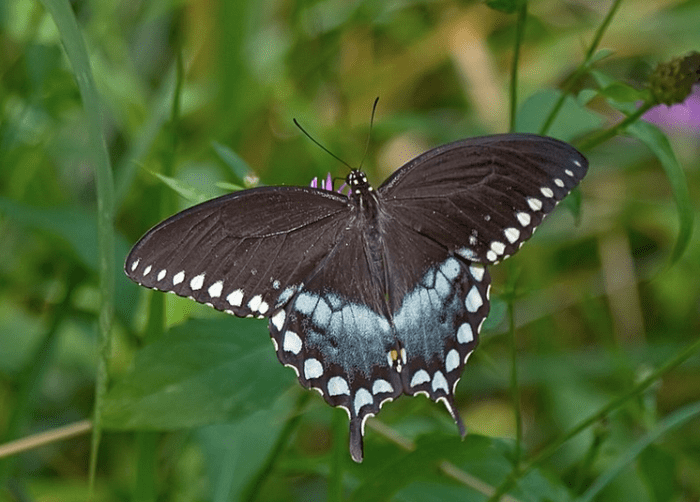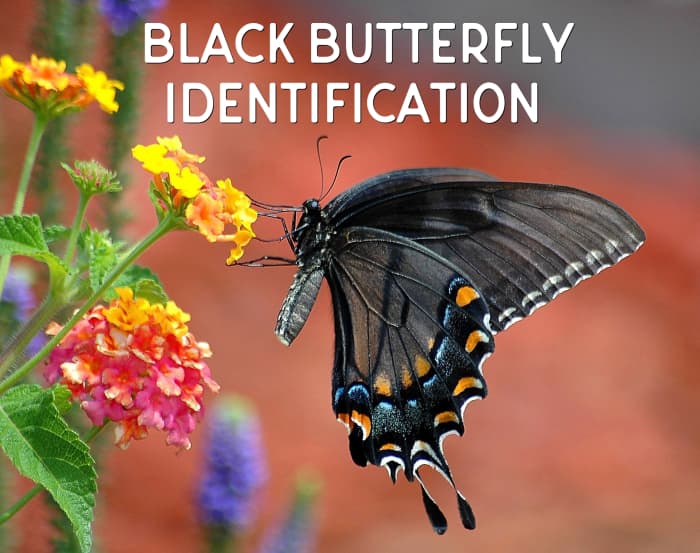Black and Dark-Colored Butterflies: An Identification Guide

Here's your identification guide to black and dark-colored butterflies.
Andrew C, CC BY 2.0 , via Wikimedia Commons
Black and Dark-Colored Butterfly Identification
If you saw a black butterfly and you're wondering what kind it is, this guide can help. It has clear, easy-to-understand descriptions and useful photos that will help you identify the black or dark-colored butterfly you saw.
There are not many all-black butterflies in North America, but many have a black or dark ground color. This guide includes those butterflies as well since often that is the most noticeable feature.
Quick, Easy Identification Chart for Black Butterflies Pictured in This Guide
| NAME | IDENTIFICATION | HABITS |
|---|---|---|
Tiger Swallowtail, dark-form female | Very large; closely resembles female black swallowtail | Soaring flight; nectars with fluttering wings |
Spicebush Swallowtail | Large; green or blue clouding on hindwing | Visits flowers; caterpillar on spicebush |
Red-Spotted Purple | Black with blue hindwing; resembles pipevine swallowtail | Flies with wings outstretched; visits carrion and dung |
Pipevine Swallowtail | Black with shining blue hindwing; tails | Flies fast in open fields |
Zebra Longwing | Dark brown with yellow stripes | Fluttering flight along forest edges |
Mourning Cloak | Very dark brown-maroon with yellow edges | Flies in early spring along wooded rows and edges |
Red Admiral | Brown with red and yellow markings | Very common in urban areas; flies in the late afternoon |
Black Swallowtail | Black with yellow and some blues on hindwings; tails | Visits parsley and carrot plants in urban gardens |
Giant Swallowtail | Very large; dark brown with yellow spots/bands | Fast, wide-ranging flights; flutters as it feeds |
Dusky and Sooty Wings | Small, inconspicuous; brown/black | Low-flying, easy to miss |
1. Tiger Swallowtail, Dark Phase Female (Papilio glaucus)
Tiger swallowtails are big, beautiful butterflies that are typically identified by their bold yellow-and-black stripes, hence their common name. However, many females emerge from the chrysalis, not yellow at all—instead, they are almost entirely dark smoky brown or even black. They have all of the other markings typical of the species except for the signature yellow-black striping.
It's been proposed that this color pattern mimics the toxic (and therefore protected from predators) pipevine swallowtail, Battus philenor. There are many other butterflies that have the same black-with-blue-hindwings coloration of B. philenor, so it does seem possible that the dark tiger swallowtails are gaining some protection by sharing in the mimicry complex.
Tiger swallowtails have an unusual life history. The adults are on the wing in mid-summer, wheeling high among the branches of ash and cherry trees, where the big females lay their eggs. The caterpillar, which is green with little "false eye" spots near its head, feeds until it is about half-grown and then builds a little shelter by pulling together the edges of a leaf. It overwinters in this shelter and emerges in the spring to continue feeding. It will pupate in early summer, and then the adults hatch to complete the process.
Fast Facts
- What is the scientific name? Papilio glaucus.
- What does it eat? Willow, wild cherry, and other trees.
- Will it seriously damage plants or trees? No.
- Is it rare? No, this species has a wide range.
- Where does it occur? This species occurs throughout the eastern US; there are similar species throughout North America.
- Can you raise it from caterpillar to adult? Yes, if you give it plenty of the food plant you found it on.

Spicebush swallowtail, Papilio troilus
By Greg Hume - Own work, CC BY-SA 3.0, https://commons.wikimedia.org/w/index.php?curid=17707578
2. Spicebush Swallowtail (Papilio troilus)
The spicebush swallowtail, like the tiger swallowtail, is a big, beautiful butterfly that rarely escapes notice as it glides by. The ground color is dark, and it very much resembles the dark-phase female tiger (above); you will need to get a very good look to be able to make an accurate identification.
The best-identifying features of the spicebush swallowtail, apart from the butterfly's large size and black-brown color, are the green or blue "clouding" on the hind wing and the large, green-yellow spots along the edge of the hindwing. If you see a large, dark-colored butterfly with these markings, you can be pretty sure that it's a spicebush swallowtail.
Fast Facts
- What is the scientific name? Papilio troilus.
- What does it eat? Spicebush and related plants.
- Will it seriously damage plants or trees? No.
- Is it rare? Uncommon in northern states.
- Where does it occur? This species occurs throughout the southeastern US.
- Can you raise it from caterpillar to adult? Yes, if you give it plenty of the food plant you found it on.
3. Red-Spotted Purple (Limenitis arthemis astyanax)
The red-spotted purple is a beautiful butterfly with a dark brown, nearly black ground color, marked on the trailing edges of the hind wings with shimmering, iridescent blue. On the underside, it has a complex pattern of orange and red spots. Individuals of this species in the northern part of its range have a bright white stripe across both wings; this butterfly is commonly known as the "white admiral."
Recommended
Those readers familiar with the viceroy butterfly, the remarkably accurate mimic of the monarch butterfly, may know that it is closely related to the red-spotted purple. The fact that these two species are so closely related makes the radical difference between them even more amazing.
The red-spotted purple is especially beautiful on the underside, so if you ever get to see one up close, you'll want to keep your camera handy.
Fast Facts
- What is the scientific name? Limenitis arthemis astyanax.
- What does it eat? Willows and other trees.
- Will it seriously damage plants or trees? No.
- Is it rare? No, this species has a wide range.
- Where does it occur? This species occurs throughout the eastern US.
- Can you raise it from caterpillar to adult? Yes, if you give it plenty of the food plant you found it on.
4. Pipevine Swallowtail (Battus philenor)
This truly beautiful insect is part of a large group of tropical swallowtails that often have iridescent blue or green on their wings. This widely distributed genus (Battus) includes some of the most striking swallowtail butterflies in the tropics. The pipeline swallowtail is usually found only in the southern states, but it has been spotted as far north as Manitoba, especially later in the summer as multiple broods spread north. Still, if you see a large dark butterfly anywhere north of the Carolinas or Missouri, you should not expect it to be a pipevine swallowtail—there are many other similar-looking butterflies that are much more common in the north.
This insect is believed to be the model for a number of other species that mimic its blue-on-black coloring. The larvae and the adult may be poisonous or distasteful to predators like birds and lizards, making it a good idea to look the same whether or not you yourself are poisonous.
Fast Facts
- What is the scientific name? Battus philenor.
- What does it eat? Vines in the Aristolochia group.
- Will it seriously damage plants or trees? Not usually.
- Is it rare? No, this species is common throughout its range.
- Where does it occur? This species is most common in the southeastern US.
- Can you raise it from caterpillar to adult? Yes, if you give it plenty of the food plant you found it on.
5. Zebra Longwing (Heliconius charithonia)
This beautiful butterfly is a signature part of the fauna of Florida, and you will see it fluttering among flowers in city gardens and roadsides. The butterfly is very much limited in the United States to the southern part of the country. The zebra butterfly is also very common throughout Mexico and Central America.
One interesting habit of the zebra is communal roosting. As the day winds down, many individuals will find each other and "sleep" at night in groups of over 50, dispersing in the morning to nectar at a variety of flowers. Adults also consume pollen from flowers, an unusual behavior for butterflies. The caterpillars are white with black spines and feed on passionflower vines, whose toxic sap gives them chemical protection from predators.
Fast Facts
- What is the scientific name? Heliconius charithonia.
- What does it eat? The caterpillar feeds on passionflowers; the adult butterfly also feeds on pollen.
- Will it seriously damage plants or trees? No.
- Is it rare? No, although it's less common the further north you go.
- Where does it occur? American tropics.
- Can you raise it from caterpillar to adult? Yes, if you give it plenty of leaves from the food plant.
6. Mourning Cloak (Nymphalis antiopa)
You can sometimes see this beautiful butterfly flying over patches of melting snow on warm early spring days. It is one of several butterfly species that can overwinter as an adult, hiding in sheltered places during the winter months to emerge once the weather turns warmer.







